| |

MAINTENANCE OF WAY
By J.H. Forbes
Assistant District Engineer Quebec District
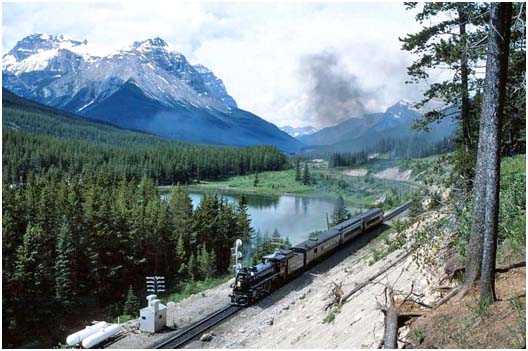
Right-of-way - Canadian Pacific Railway number 1201 at Divide in the Rockies - 1986 Phil Mason.
 Introduction Many years ago Canadian Pacific published a series of ten books named the "Foundation
Library". One particular book in this collection, published in 1937, is named "Factors in Railway and Steamship Operation".
It contains many short stories and articles dealing with the company during that period. This month's article from that book,
"Maintenance of Way", written by J.H. Forbes, Assistant District Engineer Quebec District, is reprinted here for your
enlightenment with the addition of some appropriate images.
 The 1937 Article When we speak of the "Maintenance of Way Department" we really mean the "Department of Maintenance of
Way and Structures", but owing to the length of the correct designation it has become shortened to the more familiar term. The name "Maintenance of
Way" is derived from the term "Permanent Way" which is the designation applied in England, to what we call over here the
"Track".
 Track and Structures When a company decides to build a railway it has first of all to purchase the land. That is usually a narrow strip
from 80 to 100 feet in width, reaching from one terminal to the other, with extra widths at station yards, the amount of extra land depending on the size of
the community to be served. This land is known as the "right-of way". According to the Railway Act, the railway company has to fence this
right-of-way and maintain the fences at its own expense. Upon the land so purchased, the company builds a road-bed. This may be either an embankment above or a
cutting below the natural level of the ground. Side ditches are then provided to drain the embankment and cuttings, and openings in the former are built to
carry water courses and rivers across it. These openings may be only small culverts, such as pipes, wooden, stone, or concrete boxes, or possibly large and
expensive bridges may be necessary. Upon the road-bed is placed the ballast. In Canada, this usually consists of either crushed rock, gravel, or, on
unimportant lines, cinders. Inserted in, and supported by, the ballast are the ties on which are placed the rails, fastenings, and switches.
Many types of buildings have to be provided along the right-of-way: stations, freight sheds, coaling plants, water tanks, engine houses, turntables,
cinder pits, etc. The culverts, bridges, and buildings are known as "structures" while the road-bed, ballast, ties, and rails compose the
"track".
 Organization
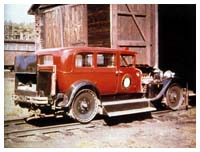
Inspection Vehicle - A relatively comfortable transport for railway inspections -
Date/Photographer unknown.
|
Before entering into details of the department and its various functions, I propose to run rapidly over the staff
organization from top to bottom. By doing so, I believe you will have a clearer idea of the whole set-up, and also be provided with a framework on which I can
place the various positions in their correct relation, one to another. There are five steps from the highest to the lowest employees. At the top is the
Vice-President and General Manager. He, however, does not personally handle the work, although he is responsible for the carrying of it out and more
particularly for the money spent. Associated and reporting to him is the Engineer Maintenance of Way, who actually handles the work. The area governed by the
Vice-President and General Manager is divided into several districts over which a District or General Superintendent rules, who also has an engineer called the
District Engineer to handle the maintenance of way work. Just as the Vice-President and General Manager's area is divided into districts, so is the district
split up into smaller units called divisions, at the head of which are the Division Superintendents. Usually, the word "Division" is left off and the
official simply called the Superintendent. He also has an engineer called the Division Engineer, who handles the maintenance of way work.
Up to this point there has been no separation between the track and the structures, or, as usually termed, the "bridges and buildings". However, from
now on the arrangement is different, so that we find there is an official reporting to the Division Engineer, in charge of the bridges and buildings, who is
called either a Bridge and Building Master, Master Carpenter, or Bridge and Building Supervisor. Each of these names is in use on the different railways. In
Canada, the most common title is that of Bridge and Building Master. For the Track Department there are one or more Roadmasters, or as they are sometimes
termed "Track Supervisors". While it is usual to have only one B&B Master per Division, it is most unusual, except on Terminal Divisions, to have
only one Roadmaster. Their number will vary depending on the length or mileage of the Division and their jurisdiction will extend from 150 to 200 miles each of
main line track depending on the importance of subdivisions, that is, density of traffic and the speed of trains.
The outline I have so far given you of the staff organization is the usual one current among Canadian railways. At this time I believe it is only right for me
to point out that my statements are based on the organization of the Canadian Pacific Railway, as I am personally familiar with it.
 B&B Master
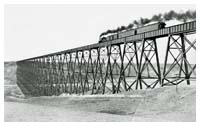
Bridges - The Lethbridge viaduct - circa 1910.
|
The B&B Master is a very important official. He is personally responsible
for all the bridges, culverts, buildings, turntables, platforms, ashpits, coaling plants, water tanks, standpipes, water columns, plumbing plants, heating
systems, and all steam, air, water, sewer, and other pipe lines. He, with his men, maintain these different structures, take care of the work of repairs and
renewals, extensions, painting, and frequently building of new structures of considerable size and value. The B&B Master himself is usually promoted from
the ranks of the gang foremen, picked out for his outstanding capabilities in the organizing and handling of his men and his ability to carry through to a
successful conclusion and without undue delays whatever work he has been given to do. B&B gangs consist of from eight to fifteen men each, the number of
men depending on the class of work on which the gang is employed. The men are divided into three classes:
(1) carpenters - men who know their trade and have a full kit of tools;
(2) bridgemen - men who are capable of rough carpentry work and are handy with tools and experienced in handling of heavy timbers. Frequently bridgemen are
promoted to carpenters;
(3) bridge labourers - usually young men who assist the other two trades and who show signs that they will eventually make good
bridgemen.
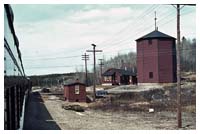
Buildings - Franz, Ontario and the junction with the Algoma Central Railway - May 1966 Douglas
Leffler.
|
With the exception of one gang, usually bossed by the oldest and most reliable foreman, which is located at division headquarters and which handles the
shipping of material to the gangs on the line and takes care of emergency repairs, sending out one or two men on repair work that can be completed in a day,
including travelling out and back, the remainder of the gangs are housed in service cars and these cars are moved from place to place as required, usually by
the wayfreights. There are generally one or more sleeping cars and a combined cook and dining car, in which the foreman usually has one end partitioned off for
himself as a combination bedroom and office. The dining car is also used as a living room. These movable gangs handle pile driver work, repairs to bridges and
trestles, buildings, platforms, culverts, pipe lines, and heating systems.
In addition to the B&B gangs there is another important employee, known as the water service man or pump repairer, who has charge of the water tanks,
standpipes, pumping plants, and of the piping serving them. He has to be a competent mechanic and is usually a combination of machinist, steamfitter, plumber,
and blacksmith, in fact, a "jack-of-all trades". He frequently has a helper. As any stoppage of the water supply on a railway is a very serious
matter, affecting the operation of the trains, his work is no sinecure, and to ensure that there will be no failures he is kept busily employed inspecting the
various structures and in repairing and renewing broken or worn-out parts. Should it happen that certain work pertaining to his part of the B&B
establishment is too large for him and his assistant to handle by themselves, the B&B Master sends a B&B gang along to help out.
In addition to this water service man, there is usually attached to the headquarters gang one or more plumbers or steamfitters. On large terminals, like
Montreal, they may reach the size of a foreman and gang of from eight to ten men. Such men handle the work of repairs and renewals or extensions to all
sanitary apparatus in buildings, to the steam, air, and water lines in engine houses, the heating systems, in fact steamfitting and plumbing work of all
kinds.
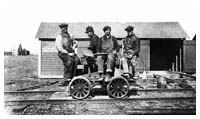
Section Gang - Maintenance of way workers - Date unknown Glenbow Museum Calgary Alberta.
|
To provide you with the clearest picture of the work carried out by the B&B Department annually, I propose now to cover an average year, outlining the
various steps. Commencing in the later summer months, the Division Engineer, accompanied by the B&B Master and each of the Roadmasters in turn on their
respective territories, makes a complete inspection of the entire Division. Each and every bridge, culvert, platform, building, in fact every structure, is
carefully inspected. Notes are made of their condition, and details of repairs and the amount of material required for them are recorded. Questions of
replacement are studied and decided upon. The requirements of the Roadmasters are also gone into, and such items as rail replacement, ballasting, fencing,
ditching, tile drainage in wet cuts, shouldering, bank widening, are carefully examined and recorded. On the completion of the inspection, the Division
Engineer has obtained a personal knowledge of actual conditions on the Division and has a written record of them. Later on, from his notes, he is able to
prepare his budget of expenditures for the following year, which is forwarded on through the higher officials to the Management for approval. By the end of the
following month of February, advice of the items that have been given approval is received and the necessary material for the coming season's work is ordered
and the programme of work laid out by the B&B Master and the Roadmaster after it has been discussed with the Division Engineer and received his
approval.
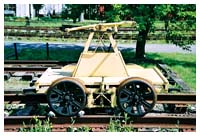
Handcar - Prior to mechanized speeders muscle moved a section gang along their section - Date
unknown Pierre Lacombe.
|
During the winter months, only such work as is absolutely necessary for the safe operation of trains and for the
handling of traffic is carried out by the B&B staff. The gangs are reduced in number, usually two or at the most three being retained. These consist of:
(1) the headquarters gang, which is reduced to a minimum as regards the number of men, and
(2) one or at the most two gangs that are required to take care of the wooden bridges, which continually get out of line and surface
on account of frost action.
As soon as spring arrives, the B&B Master consults his prepared programme of work, orders the necessary material, decides upon the number of gangs
required, and summons his laid-off men back to work, dividing them up among the gangs in the required proportion of the different trades. The pile driving
gangs get away to an early start, as the piles required for the falsework necessary for supporting the track must be driven prior to the arrival of the bridge
and culvert renewal and replacement gangs at the site. The B&B Master usually endeavours to start the gangs so that they move steadily over a subdivision
from one end to the other, completing all the minor as well as the major items as they go, as such an arrangement is the most efficient and economical method,
and the amount of travelling required to get from one job to the next is considerably reduced. This, of course, cannot always be done, as conditions will arise
which make it necessary to modify the arrangement temporarily, but sooner or later the method is again put into effect.
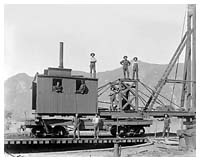
Pile Driver - A particularly old pile driver - Date/Photographer unknown.
|
In addition to these so-called "steadily moving gangs", there will be one or two other gangs suited for
special kinds of work, which will be employed on the larger items and will be transferred over long distances from one job to another. Such gangs are the ones
experienced in the work of pile driving, heavy trestle repairs, changing out of steel bridge spans, building of new stations, water tanks, or other kinds of
large frame buildings.
The B&B Master is kept busy all summer visiting his gangs, seeing that the work is being carried out efficiently and well, that it is not being delayed due
to shortage of material, and that it is being done within the time limits of his programme, so that at the end of the working season he will see all the work
completed and his department ready for the coming winter.
 Roadmaster The Roadmaster, like the B&B Master, is usually promoted from the ranks of the section and extra gang foremen. He
is picked for his experience in track work and his ability to handle men, so as to achieve the best results. He is personally responsible for the safety of the
track under his jurisdiction. His territory is divided into sections on each of which there is a permanent gang located called a "section gang",
consisting of a foreman and several section-men.

Service Car - Sleeper CP 412039 is a home away from home for an extra gang - 1950 British
Columbia Archives.
|
The headquarters of the gang is, whenever possible, located at a station where there is either a regular agent or operator and, if possible, a village. The
reasons for this are that at an open telegraph office it is always possible to get in touch with the foreman quickly over the despatching phone or the
telegraph wire in case of trouble arising, such as derailments, washouts, falling trees or poles, or any of the other mishaps that sometimes occur on railways.
The placing of the headquarters where there is a village relieves the railway company from the necessity of providing living accommodation for their men, as
they are then able to rent or purchase dwellings and, in addition, schools and markets are available.
The length of a section varies, being usually from five and a half to six and a half miles long on main lines and from six and a half to nine and a half miles
on branch lines. The length of the section and the number of men in the gang are based on the following: density of traffic moving over the subdivision,
number of miles of main line, number of miles of sidings, number of switches, road, and farm crossings, interlocking plants, and the condition or standard to
which the track is kept up. A main line section gang usually has a foreman and three men in the summer and one man less in the winter. A branch line section
has a foreman and two men in the summer with a reduction of one man in the winter. At terminal yards the gangs are increased in size and may have from seven to
fifteen men, including the foreman, depending on the size of the yard.
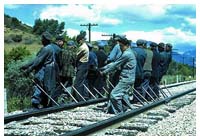
Old Fashioned Work - Heavy manual labour is required for track work in some instances -
Date/Photographer unknown.
|
The section gang is the foundation of the Track Division of the Maintenance of Way Department. It is responsible for
the track under its care being capable of carrying the trains moving over it with safety. The duties of the section gang are many, and in order to give you
some idea of the work they do I propose to outline in a rapid manner their work as they carry it out from month to month throughout the year. For this purpose,
we will suppose that we are entering on the winter season and that the previous summer's work is completed and the section in good condition to meet the
onslaught of the Canadian winter. The track may be in first-class line and surface when the frost commences to penetrate the roadbed, does it remain so? It
does not, the cold freezes and expands any water retained in the roadbed and forces the latter upwards and outwards. If this frost action called
"heaving" were uniform all along no great trouble would be experienced, but as the roadbed is composed of many different kinds of soil, each of which
retains a different amount of water than the other, the heaving is not uniform and the result is that at some places a hump is formed and at others a hollow.
If no remedial action were taken a rapidly moving train would receive a bad jolt and, in extreme cases, might be derailed.
The Railway Company provides pieces of hardwood called "shims", varying in thickness from a half inch to 3 inches and in length from 12 inches to 24
inches, with some pieces 3 inches thick by 7 feet long. The sectionmen take these and, using the required thickness and size, they make a run-off on each side
of the hump or level off the hollows so that the abrupt changes are eased off. Sometimes only one side of the track will heave requiring only one rail to be
shimmed, or possibly the track will heave out of line as well as surface, necessitating the pulling of all the spikes, and the relining of the rails on the
ties, before the shims can be applied.
The first work that a section gang has to carry out daily is the track patrol. The entire section is gone over and carefully inspected to see if everything is
in good condition, and any defects found are remedied before the day's work is started. In the winter time the largest part of the section gang's work is the
handling of snow and ice. All switches have to be shovelled out after each storm so that they will work easily for the trains. Platforms have to be cleaned,
icicles have to be knocked down from buildings, culverts have to be watched that they do not become blocked solid so as to prevent passage of water from
streams that run all the year round, ditches in wet cuts have to be kept clean of snow so that they will function correctly in case of sudden thaws, ice around
water tanks and standpipes has to be removed, road crossings have to be kept clear of snow and especially the flangeways between the rails and planks have to
be prevented from filling up with ice and frozen mud which are liable to cause derailments. Included in the work of the gang is the lighting of switch lamps.
The fonts are refilled with oil, the wicks examined and replaced if necessary, and the chimneys and lenses cleaned.
Going back to the question of shimming: If the places in the track that have heaved would remain in a stationary condition it would not be so bad, but
such is not the case, for usually as the frost penetrates more and more into the roadbed the bad spots heave higher and the shimming has to be adjusted to meet
the trouble.
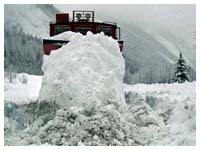
Snowplow - Used for clearing main line track - Date/Photographer unknown.
|
The sectionmen are kept busy all winter coping with the matters mentioned, and as soon as spring puts in an
appearance it is necessary to clean out the snow from all ditches carrying large streams of running water, and from entrances to culverts and small bridges, in
order to give the water an unimpeded course. Rails and angle bars, whose defects were covered up by the snow and which now show up, have to be changed out with
good material and all the bolts have to be gone over and tightened. As soon as the frost commences to leave the roadbed, the shims have to be removed
progressively to keep the track smooth riding. When all the snow has gone and the ground commences to dry out, the grass on the right-of-way has to be burned,
otherwise fires would start later on in the summer from the dry grass of the previous year. Also, at this time the new ties are distributed to the locations
where the decayed ones are to come out and the work of replacement is started as early as possible. During all this it must not be forgotten that the daily
patrol has to be made and any bad spots in the track attended to.
With the coming of spring the summer forces are authorized and the men report for duty. On the completion of tie renewals, a gang starts in on the surfacing.
It is the usual arrangement that the section is given a general surfacing from one end to the other over a period of three or four years, that is, either a
third or one-quarter is completed each year. The term "surfacing" means that the rails are levelled up to the same horizontal plane on tangent or
straight track and the low spots in the general longitudinal plane are raised to the grade level. Also that the required elevation on the outer rail of curves
is provided. As the surfacing work extends into the autumn months, it is necessarily interrupted by other seasonal duties such as mowing the right-of-way of
grass and weeds, removing the weeds from the ballast section when the weed killer machine is not operated, keeping the fences repaired to prevent stock getting
on the right-of-way, renewing farm and road crossing planks, overhauling and repairing switches, cleaning all station yards, etc. In the fall the ditches have
to be cleaned out and culverts that have become blocked with silt and sand have also to be attended to, so that everything will be in good condition to handle
the fall rains.
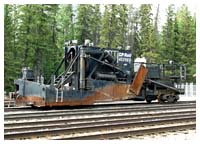
Jordan Spreader - Wide blades cans spread the snow across several tracks - Date/Photographer
unknown.
|
Owing to the size of the section gang, there are not enough men in one gang to handle large works such as ballasting,
renewal of long stretches of rail, fencing in large amounts, switch renewals and replacements, and new construction such as extensions to sidings and yards,
building of industrial sidings to accommodate private business firms, etc. To carry out such works extra gangs are employed. These consist of an extra gang
foreman and anywhere from twenty-five to one hundred men. The foreman is almost invariably one of the senior section foremen who has demonstrated his ability
to handle large gangs of men and to carry out the work satisfactorily. As the pay of an extra gang foreman is higher than that of a section foreman there are
always plenty of applications received when the positions are advertised by the Roadmaster. The men in the gang are called labourers or extra gang men and are
paid at lower rates than the regular sectionmen, the rate of pay being based on the then existing market value of a labourer. The extra gang usually works a
ten-hour day as compared with an eight-hour day for the section gang. They are housed in service cars which are moved from place to place as required.
The Roadmaster, like the B&B Master, is advised early in the spring of the work that has been authorized and he also has to make out a programme for the
summer season, decide how many extra gangs are required, organize them, and start them at the work. All through the summer he has to keep in touch with both
the section and extra gangs to see that the work they are doing is being carried out diligently and satisfactorily, and that the materials required for the
different classes of work are supplied in sufficient time to avoid delays, as nothing wastes a Roadmaster's money more quickly than a large extra gang being
held up due to lack of some necessary article. The Roadmaster frequently requires the use of trains in the handling of his work, for the purpose of unloading
or loading material and spreading ballast or stone, or snow, and such trains are called "work trains". A first-class man will so handle his work that
the use of work trains is reduced to a minimum, thus saving the Railway Company large amounts of money, as the expenditure for work trains rapidly mounts,
especially when in use on lines of heavy traffic where it is necessary for them frequently to get out of the way to allow schedule trains to pass, with the
result that but little work is accomplished in any one day.
The question of snow removal in the winter time is another item handled by the Roadmaster. He and his men make up the snow fighting forces. To assist in the
work, the Company provides snowplows, flangers, and spreaders, but it is still necessary for a large amount of the work to be handled by the old-fashioned pick
and shovel, especially is this true around large terminals where there are many switches and other facilities which prevent the operation of snowplows in their
vicinity.
The snowplow foreman is usually one of the extra gang foreman and he is in direct charge of the work of the plow. He has an assistant in the plow to help him.
A special train is the rule for operating it, the plow being pushed ahead of the engine and van. On the other hand, the flanger is usually hauled by one of the
regular freight trains, either way or swing freight, and is operated by one man only. To clear the snow from railway yards the snowplow is usually operated in
conjunction with the spreader, the plow being placed ahead of the spreader. It throws the snow to one side and the spreader wings, which can be extended for a
considerable distance, force the snow at least as far as the centre of the next track. When one siding is clear, the process is repeated on the next adjoining
siding until the entire yard is cleared, the snow being carried across to one side where it is either left or where it possibly has to be loaded up in cars and
hauled away to be unloaded at some convenient location.
 Rail and Switch Work Welding In recent years the process of welding steel has been used with great success in the building up of battered rail
ends and the worn portions of frogs, switch points, diamond crossings, and also angle bars. The weakest link in the rail is the joint, and the wheels of the
rolling stock passing over it batter down the ends of the rail until a condition is reached when it is necessary to replace the rail on account of the track
riding very roughly, which may give rise to complaints from passengers, especially on sleeping cars, and may cause breakage of parts of the cars or
locomotives.
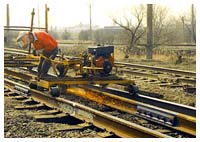
Rail Grinding - The rail must be ground to the correct shape after welding - Date/Photographer
unknown.
|
By the use of either electric arc or oxyacetylene welding units, it is possible to build up the battered or worn parts in their place in the track with new
metal and thus avoid the purchase of new material. Providing that steps are taken to have the welding work carried out before the article to be repaired has
become too far gone, large savings can be made. There are two methods of handling the welding work, and each has its supporters, they are:
(1) welding by contract, the work being carried out by a private firm, or
(2) the Railway Company purchasing the necessary welding units and material and carrying out the work with its own employees.
The latter arrangement is the one in effect on the Canadian Pacific Railway, and all of the welding units in service are electric ones. The welders and their
assistants are men picked from the section gangs and trained in the work, and it is only right for me to state that they become skilled and able to do very
good work in a surprisingly short time. The Roadmaster is in direct charge of the work under the supervision of the Division Engineer. In the actual work,
parallel beads of metal are laid down on top of the rail or other article to be built up until the surface is completely covered. A grinder is then used to
remove any surplus material and to bring the welded portion of the article to the required shape.
 Division Engineer The Superintendent is the official at the head of the Maintenance of Way organization on the Division, but associated
with and reporting to him in all matters, except those of a technical nature, is the Division Engineer, who has actual charge of the work. On technical
subjects he reports direct to the District Engineer. His duties are both of an executive and supervisory nature. It is necessary for him to spend the greater
part of his time on the road to see that the work in progress is being carried out in accordance with the plans prepared and the arrangements decided upon,
that the railway standard practices are being lived up to, and that the work is proceeding at a satisfactory rate. He is usually accompanied on these trips
either by the B&B Master or Roadmaster, as the case may be, and the work is discussed fully on the ground. In this way any decisions required can be given
by one fully conversant with the actual conditions. To assist the Division Engineer there is a staff consisting of usually a permanent transitman employed all
the year round and frequently a permanent rodman. In the spring additional men are taken on staff as found necessary, their number depending entirely on the
amount of work to be handled. This staff take their orders direct from the Division Engineer. They make all necessary surveys and plans for new work, drainage
complaints, accidents, purchase or sale of lands, claims against the Company, leases, etc. In addition, they lay out and place stakes for all new construction
or alterations to existing facilities when such are required and indicate to the gang foremen their location and meanings. They also give levels for any work requiring them, such as grade stakes for raising track when ballasting or for pipe lines and sewers, or for setting tops of building foundations, bridge piers, and abutments. They also have to measure up new work on its completion to get the data to revise the records kept in either the office of the Division
Engineer, District Engineer, Engineer Maintenance of Way, or the Chief Engineer.
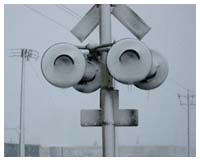
Crossing Protection - Snow cover interferes with flashing lights - Date/Photographer
unknown.
|
One of the most important duties of the Division Engineer is that of control of expenditures. On or about the fifteenth of each month the B&B Master and
each Roadmaster submit to the Division Engineer a statement of the work that it is proposed to carry out the following month. This statement shows the number
of men he will employ and the amount of money required. These statements are carefully studied and revised if necessary as the Division Engineer is usually
given previously an approximate idea of the amount of money that will be approved, this amount depending on the financial policy of the Company at the time.
The statement, when in shape, is forwarded to the General Superintendent along with the standard form giving all other expenditures for the Division, such as
running trades, station employees, etc. About the first of the following month notice is received of the amount of money authorized. The Roadmasters and
B&B Master are then advised of their portions and from then on it is necessary to keep close check on the actual expenditures to see that they will not be
over-expended.
Each spring, after the spring freshets are over, it is necessary for the Division Engineer, accompanied by the B&B Master and Roadmasters, to make a
complete inspection of his Division, paying special attention to the condition of bridges, culverts, water courses, and bank protection, to make sure that no
bad condition has arisen during the previous winter that will require prompt attention to safeguard the track. I previously mentioned the thorough fall
inspection that is carried out every year. The Division Engineer from his notes thereby obtained prepares his estimate of the cost of the works he has to
recommend for the following year. Should any new work be decided upon by the Superintendent and himself, the necessary surveys have to be made and plans and
estimates prepared. A list of the proposed works is submitted to the General Superintendent, and when word is received of provisional approval he then has to
prepare his budget on the approved standard forms.
 District Engineer The District Engineer handles the Maintenance of Way work for the General Superintendent, reporting to and associated
with him, except in regard to technical matters. In these he reports direct to the Engineer Maintenance of Way. To assist him in his duties he may have an
assistant called the "Assistant District Engineer", a Signal Supervisor, and a District Electrician. The duties of the District Engineer are both of
an executive and a supervisory nature. He makes frequent inspection trips over the District, accompanied by the respective Division Engineers, and acts in a
consulting capacity, in virtue of his broader experience, on questions of engineering referred to him for decision and on questions of policy. He usually
accompanies the General Superintendent when the latter makes periodical inspection trips over different parts of the District, placing his training and
experience as an Engineer at the General Superintendent's service. As soon as the Division Engineers have completed their fall inspection, the District
Engineer in turn carries out his inspection. He carefully examines all bridges, any culverts where repairs or renewals are necessary, any buildings requiring
replacements or heavy repairs, ballast and rail requirements, and discusses conditions with the Division Engineer and his officers, taking notes so that when
he receives the annual budget from his Division Engineers he is personally familiar with the actual conditions and is in a position to know what work asked for
is absolutely necessary, what work is desirable, and what if necessary can be postponed. The monthly requests for expenditure also come to the District
Engineer for approval and action, if necessary, and are referred to the General Superintendent prior to being forwarded to the Vice-President and General
Manager.
The Assistant District Engineer assists the District Engineer in all his duties, acts in his place when he is away from the office, and handles all routine
matters so that his superior will have ample time to consider the major questions that come up from time to time and also to make his inspections. The general
fall inspection is usually divided up between the two men and, in addition, the Assistant is usually sent out on special inspection trips of a short duration
in order that he will be able to keep in touch with conditions on the District and with the work that is in progress.
 Signal Supervisor
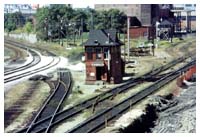
Interlocking Tower - Cabin D in Toronto, Ontario - Date/Photographer unknown.
|
The Signal Supervisor is in direct charge of all maintenance and construction of automatic signals, crossing
protection appliances such as gates, wigwags, bells, flashers, etc., train order boards, and interlocking plants. His duties are of a supervisory nature almost
entirely and he spends the greater amount of his time on the road with his men, checking up conditions, giving advice and instructions, and seeing that the
work is being carried out correctly. To handle the maintenance work the Divisions are divided up into sections in charge of which are placed a
signal-maintainer and a helper, who have a light track motor for transporting themselves over their territory. Their headquarters are usually located at an
interlocking plant if there is one situated on their section, so that they will be available promptly in case of trouble on these important installations.
These men come under the Superintendent for discipline and pay, but report direct to the Signal Supervisor in other regards. They are held responsible for the
correct functioning of the signals under their care as well as for their maintenance and repairs.
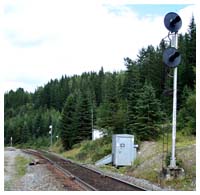
Signal - The west switch at Cathedral Siding - Date/Photographer unknown.
|
Should it become necessary to undertake any new work such as an extension of the automatic block signal system,
installation of new protective appliances at highway crossings, installation of a new interlocking plant, or heavy repairs to an existing one, when the work is
so extensive that it could not be handled by a maintainer and his helper without interfering with their regular duties, a signal extra gang is organized. A
foreman is obtained from one of the senior maintainers and sufficient wiremen, carpenters, blacksmiths, labourers, etc., are hired. These men are housed in
service cars which are moved from place to place as required. It usually happens that there is sufficient work on most districts to keep at least one extra
gang steadily employed all the year round. In technical matters the Signal Supervisor reports direct to the Signal Engineer, who forms part of the Engineer
Maintenance of Way staff.
 District Electrician This official is in direct charge of all electrical wiring and appliances on the District. To carry out the work of
repairs and replacements of motors, electric heating units, wiring for power and lighting, etc., he has a staff of qualified electricians, usually averaging
one per Division. On larger terminals these must necessarily be increased, the additional number depending on the amount of electrical equipment to be cared
for. The District Electrician handles all electrical contracts and also checks electrical bills when they are received. On the Canadian Pacific Railway he is
also in charge of the repairs and maintenance of the rail welding units, and for this work his staff includes a gas-electric engine maintainer, who looks after
the mechanical repairs, the electrical portion being handled by his electricians.
 Engineer Maintenance of Way The Engineer Maintenance of Way is associated with, and reports direct to, the Vice-President and General Manager in
all matters pertaining to the Maintenance of Way Department, except those of a technical nature, such as standards and designs. In these he reports direct to
the Chief Engineer. He holds practically the same position relative to the Vice-President and General Manager's area as a District Engineer holds to the
District, except that he is engaged on executive matters to a much larger extent, and has not as much time at his disposal to make inspection trips over the
line under his jurisdiction. He, therefore, is forced to rely to a greater degree upon the reports he receives from the District Engineers and his own
assistants. He has control of all materials required for, and released by, the Maintenance of Way Department and disposes of them at his own discretion after
obtaining sanction from the Vice-President and General Manager.
The annual budget of proposed works is received by him, carefully studied, revised if considered necessary, and then passed on to the Vice-President and
General Manager with his recommendations. On receipt of advice of the amount of money allotted for new rail, tieplates, other track materials, and ballast, he
decides upon the distribution amongst the various Districts in proportion to their needs.
The monthly statements of proposed expenditures are also received by him, given his careful consideration, and referred to the Vice-President and General
Manager for approval. To assist the Engineer Maintenance of Way in his work, he has an office assistant engineer who handles all routine matters and acts in
his place when he is away from the office. A Signal Engineer and one or more Assistant Engineers who spend the greater part of their time on the road making
inspections, travelling with the Division Engineers and Roadmasters, keeping them abreast of the times in regard to new and better methods of handling their
work, and checking up on the installation of various kinds of materials to see that they are correctly applied in accordance with the Company's standards and
regulations. They also take note of track conditions, making full reports to the Engineer Maintenance of Way, especially on rails, fastenings, switch material,
and ballast, so that he will have a record of the necessary data from which he can arrange his distribution of new or released materials. From them he is able
to obtain an unbiased opinion of conditions on the several Divisions and Districts, as naturally each Divisional or District Officer attempts to present his
requirements in the best light in order to obtain the desired material or money he is asking for.
 Signal Engineer This official reports to the Engineer Maintenance of Way direct. His position is both executive and supervisory. He
is in charge of the maintenance and construction of all automatic block signals, highway crossing protective appliances, interlocking plants, and train order
boards. He makes frequent trips over the road accompanied by his respective Signal Supervisors and familiarizes himself with conditions in the field and in
regard to the progress of any new installations. He prepares the necessary plans for the signal layouts and checks the Signal Supervisor's estimates of their
cost, having a staff of draughtsmen for this purpose, their number depending on the amount of work in progress. He also passes on all requisitions for material
submitted by the Signal Supervisors before forwarding them to the Engineer Maintenance of Way for approval.
 Chief Engineer
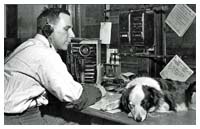
Operator - John Ruston works the night shift at Stephen - 24 Jun 1924 Photographer
unknown.
|
At the head of the Engineering Staff of a railway there is a Chief Engineer. He and his staff act in the capacity of
consulting engineers for the Maintenance of Way Department. On his staff are included an Engineer of Bridges, an Engineer of Buildings, an Engineer skilled in
yard layouts, an Office Engineer, and also Assistant Engineers and draughtsmen for each sub-department. All records of bridges, buildings, rail, etc., are kept
in his office and all questions of a technical nature are referred to him and his staff by the Engineer Maintenance of Way. The design for a bridge, building,
or large yard proposed by the Maintenance of Way Department will be worked out by the Chief Engineer's staff and plans and estimates of cost supplied to the
Engineer Maintenance of Way, who forwards them to the District Engineer and he in turn to the Division Engineer.
Prior to closing my remarks, I wish to draw your attention to the intimate connection that exists between the Operating and Maintenance of Way Departments,
from the Vice-President and General Manager's office down to the Superintendent of the Division. This permits of very close co-operation and the officials of
the separate departments are always posted in regard to any operation or construction work that is being carried out, with the result that large savings are
able to be made in the handling of the Maintenance of Way work, as it is frequently possible to alter the running time of freight trains to provide a larger
period of time for the carrying out of any particular construction operation, such as the change out of a bridge span, when it is necessary to have four or five
hours' uninterrupted time in order to be able to break the track, remove the old span, install the new one, and couple up the track again for operation. In
addition, where there is a double track in existence, it may be possible to single one track, operating trains in both directions over it, and turn the other
track over to the Maintenance of Way Department for long periods of time to enable the laying of rails or placing ballast in large quantities, without any
interruption by train movements.
 Associated Web Sites Canadian Pacific Railway
CP Shop
Royal Canadian Pacific
Canadian Pacific Historical Association
Additional CPR Web Sites

|
|

